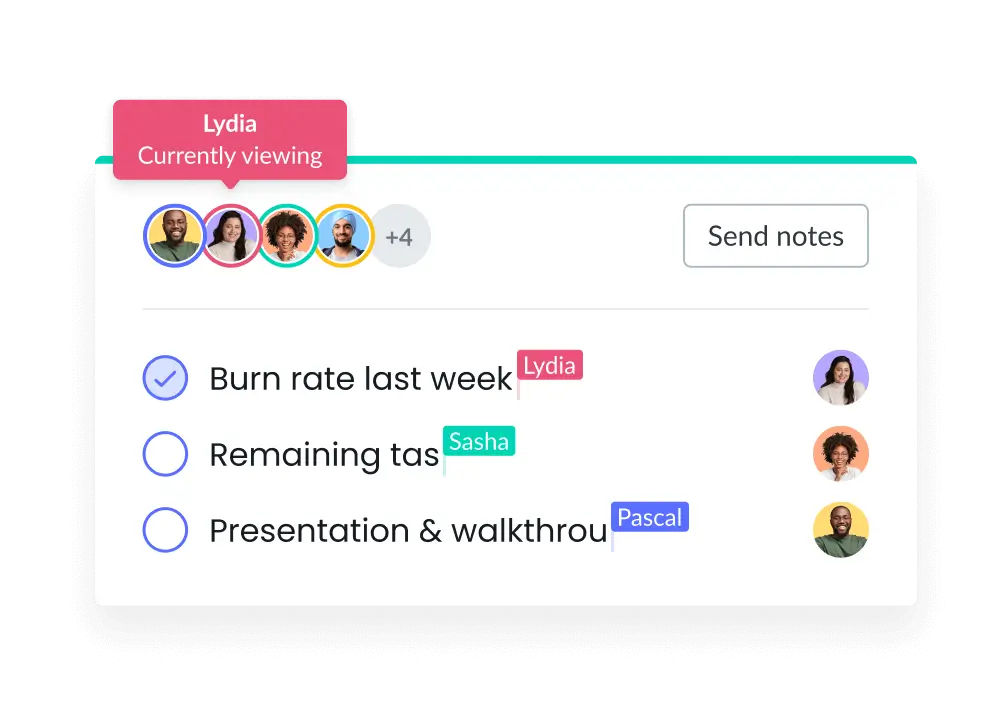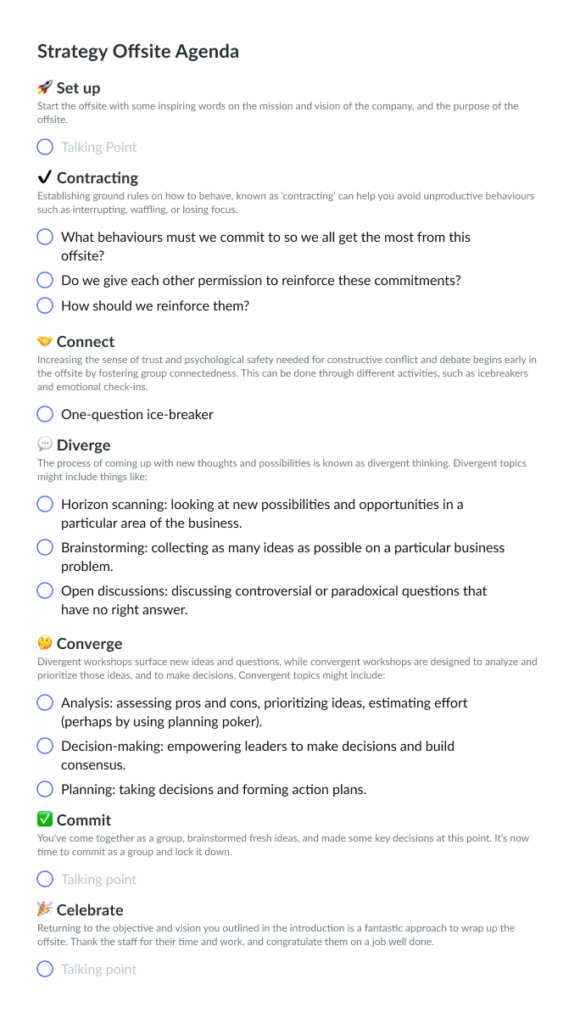Elevate Your Strategy: 13 Offsite Meeting Essentials
Planning a great strategy offsite meeting can help your team spark new, creative ideas. Learn strategy offsite meeting the best practices!
One of the main reasons that hybrid work became so popular recently (besides local pandemic restrictions lifting) is that people genuinely enjoyed having a fresh change of scenery to get work done. Being able to bounce back and forth between the office as needed enabled a great combination of focus time and stimulation to help drive peak creativity.
In fact, it’s been scientifically proven that creating some diversity in your work environment can improve your productivity and overall mental well-being.
Offsite meetings work for a very similar purpose: to help you spark some creativity while isolating your meeting topic so you can come to deeper, better solutions to a challenge.
- What is a strategy offsite meeting?
- 13 tips to run a successful strategy offsite meeting
- Free strategy offsite meeting agenda template
What is a strategy offsite meeting?
An offsite meeting takes place outside the office and can take place in a lot of forms. A strategy offsite meeting, therefore, is any meeting outside of the office to specifically focus on setting strategic plans.
Running offsites is a popular approach for executive teams as they plan long-term strategic goals. It’s also great for any team that needs to get a fresh environment to isolate and solve a specific set of challenges the team is facing. Offsites can take place anywhere. For example, an offsite meeting might be in a nearby event space that’s rented out for the afternoon or somewhere further away for an overnight retreat.
Wherever you hold your offsite, and for whatever reason you need to start deeply strategizing, there are a few key tips to help you make the most out of your focus time.

Run productive strategy offsite meetings
Increase meeting engagement and productivity with a collaborative agenda that the whole team can contribute to. Try using a tool like Fellow!

13 tips to run a successful strategy offsite meeting
- Only invite those who need to be there
- Set clear expectations (like the meeting ground rules)
- Create and share a meeting agenda
- Assign meeting roles
- Take collaborative meeting minutes
- Open with an icebreaker
- Focus on working on the business, not in the business
- Create a parking lot
- Communicate the purpose of the meeting to attendees
- Come to a decision (don’t end with maybes)
- Separate divergent and convergent thinking
- Send a meeting follow-up email
- Ask for meeting feedback
1Only invite those who need to be there
The whole point of running a strategy offsite is to get deep into solving the issue at hand. The more people that get invited to the outing, the less likely you’re going to be able to focus as deeply as you’d like. This is largely because more people means more opinions and perspectives to consider. As well, having more attendees can increase distraction, add complexity to the planning of the event, and make it more difficult to grab attention at important times—for example, if you have such a large group that it’s hard to organize or calm the group.
2Set clear expectations (like the meeting ground rules)
To maximize your time in the meeting offsite, set clear ground rules ahead of your outing. Doing this before you leave ensures that you can successfully hit the ground running when you get there, and avoid any disruptions or delays to the day’s activities. Meeting ground rules can cover anything, including:
- What time attendees are expected to arrive or depart
- The dress code, if necessary
- Processes or rules for speaking in turns
- Anything else that will help your meeting run smoothly
3Create and share a meeting agenda
While your meeting agenda should always be the main star of your event, it’s even more so in an offsite meeting. In a new environment, participants can get overwhelmed or easily excited, therefore possibly distracting them from the meeting’s purpose. Having a well-structured meeting agenda shared with your team reminds team members of the goals of the meeting and ensures that all topics can be covered in a timely fashion. It’s recommended that you share your agenda with your team members at least 24 hours ahead of the meeting so they can prepare and provide feedback if necessary.

4Assign meeting roles
Assigning meeting roles is a fantastic way to keep your team engaged during the strategy offsite. By providing everyone with a specific task during the meeting, you help ensure that your meeting stays on track and within your specified time limits.
Also, if you’re having longer offsites for strategy planning (that is, offsites lasting a day or longer), consider switching up people’s roles at regular intervals so they have fresh responsibilities and can maintain better engagement. Switching roles works great if your offsite is longer and you can break it up into several smaller meetings that work on more defined topics. Roles like timekeeper, note taker and voice of the customer are best for switching up.
5Take collaborative meeting minutes
Meeting minutes are essentially the notes that are taken from the meeting. They include a review of discussion topics, decisions (including rationales for decisions), and action plans for after the meeting. Taking meeting minutes collaboratively means encouraging all or multiple members of your meeting to work in one document together for the minutes. If you use a tool like Fellow, you can track meeting minutes collaboratively while also viewing and following the meeting agenda (a double whammy on meeting organization!).
6Open with an icebreaker
Regardless if your team members are new or have known each other for decades, an icebreaker is a fantastic way to kick off your strategy offsite. As offsites typically delve deeper into more serious, challenging topics, an icebreaker provides a fun intro to stimulate some creative juices and create team bonding (which further helps problem-solving capabilities!).
7Focus on working on the business, not in the business
Working strategically versus tactically is very different, and can be challenging for a lot of people to switch between. To drive the most value out of your offsite meeting, it’s important to continue placing value on the strategic angles that you need to get sorted out.
For example, this means looking at high-level ways to build revenue, improve productivity concerns, and continue growing brand awareness for the company. To do so, avoid getting too deep into the technical, everyday workings “in” the business, like specific marketing or sales tactics or a specific new product that needs to be released. Build the core structure and overarching goals for the company now, and use your solutions to dive deeper into more tactical elements at a later meeting.
8Create a parking lot
No, not a parking lot for parking your car when you arrive at the offsite. This type of parking lot is a meeting management strategy that helps you flow through your meetings more efficiently. If you have an idea mid-meeting that could be useful at a later time, make note of it on a whiteboard or sticky note to remember for later. This same technique can be applied when meeting discussion is starting to get off track. This way, valuable ideas are not forgotten, but the meeting agenda can still be followed as planned.
9Communicate the purpose of the meeting to attendees
With offsites, it’s especially important to communicate the meeting’s purpose. You’re asking attendees to go somewhere that’s not their typical working environment, so they’re going to want to know why you’re meeting in the first place, and why this type of meeting needs to take place outside of the office. In addition to your own reasons for why you’re hosting the offsite, also remind your employees that it’s great to get a fresh change of scenery once in a while, and that doing so can spark some innovative new solutions.
10Come to a decision (don’t end with maybes)
A lot of planning goes into offsites, and they’re usually held for a super specific purpose. Don’t let these efforts go to waste by ending your meeting with inconclusive decisions. If your team is struggling to come to a decision during your meeting, consider putting several “deciding factors” into place. Some brainstorming approaches include having ways to measure new ideas to decide if they’re valuable solutions to your challenge.
When you’ve come to your decision, make note of your rationale in Fellow’s meeting minutes app; doing so is not only important for accountability in later strategy planning stages, but can also be helpful for communicating decisions to stakeholders who were not present at the office.
11Separate divergent and convergent thinking
Convergent thinking is working towards a common solution, and divergent thinking is looking at separate solutions. Both are needed in great problem-solving meetings to maximize everyone’s creative brain powers. As Zack Onisko shared in episode 108 of the Supermanagers podcast,
“The great way that designers solve problems is we tend to think divergently. Great designers have the ability to think outside constraints of what’s already there, scrap it, and come up with something completely new.”
12Send a meeting follow-up email
Sending a meeting follow-up email is like putting a bow on a present—it’s the final touch. In this message, you can thank meeting attendees for their time and ideas, and share the meeting notes. You also want to communicate any next steps, like action items assigned to specific team members or plans for the next meeting date. Sending this meeting follow-up email ensures that all participants have a takeaway summary of the event so it’s easy to refer to at a later date.
13Ask for meeting feedback
When sending out your meeting follow-up email, you can also ask for meeting feedback. Asking for meeting feedback ensures that you see the perspectives that your participants had on the offsite meeting so you can better prepare for future occurrences. This is especially important if you’re hosting an offsite for the first time!
To make your life even easier, Fellow also has a meeting feedback feature. Simply input a few meeting feedback questions and ship the survey off to your attendees! They will be notified by email, so it’s a fast and efficient way to get responses regarding how your meeting went.

Free strategy offsite meeting agenda template
If you’re looking to run your own strategy offsite meeting, consider this template to guide your agenda!

Parting advice
Getting a fresh space to work in can make a huge impact on employee success. While many employees practice changing up their work environment for their day-to-day work, leaders shouldn’t forget to do the same when it comes to planning important elements of the future of the business. With a bit of proactive planning, a lot of clear communication, and a great meeting structure to follow, you’ll be on your way to running an efficient strategy offsite meeting in no time!











